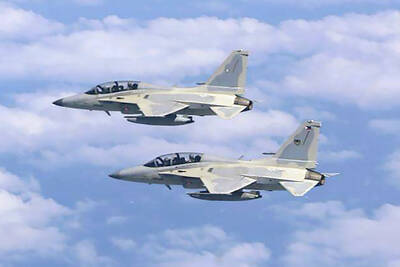North Korea conducted a new round of artillery drills near the disputed sea boundary with South Korea on Saturday, officials in Seoul said, a day after the North’s earlier exercises prompted South Korea to respond with its own drills in the same area.
The South Korean Joint Chiefs of Staff said in a statement the North fired more than 60 rounds near the western sea boundary on Saturday afternoon.
It said South Korea strongly urges North Korea to halt acts that heighten tensions.

Photo: AFP
The Joint Chiefs of Staff said South Korea will take corresponding military steps if North Korea continues artillery drills that pose a threat to South Korean nationals.
It said South Korea will “overwhelmingly” deal with any provocations by North Korea.
On Friday, North Korea fired about 200 artillery shells near the area, prompting South Korea to conduct its own firing drills in response. South Korean Ministry of Defense said troops on two border islands fired artillery rounds south of the sea boundary.
Local media said South Korea fired 400 rounds.
Ahead of the South Korean drills, South Korean authorities asked residents on five major islands near the western sea boundary to evacuate to safe places due to worries that North Korea would fire back. The evacuation order was lifted a few hours later.
Both Koreas have abandoned a 2018 deal they struck during a brief period of rapprochement. The agreement called for a halt in live-fire exercises in front line buffer zone. However, rising animosities over the North’s missile tests and its first military spy satellite launch and other issues have left the military agreement in tatters.
The Koreas’ poorly marked western sea boundary was the site for bloody naval skirmishes between the Koreas in 1999, 2002 and 2009. The North’s alleged torpedoing of a South Korean warship killed 46 South Korean sailors in March 2010, and the North’s artillery bombardment of Yeonpyeong Island killed four South Koreans in November 2010.

TURNAROUND: The Liberal Party had trailed the Conservatives by a wide margin, but that was before Trump threatened to make Canada the US’ 51st state Canada’s ruling Liberals, who a few weeks ago looked certain to lose an election this year, are mounting a major comeback amid the threat of US tariffs and are tied with their rival Conservatives, according to three new polls. An Ipsos survey released late on Tuesday showed that the left-leaning Liberals have 38 percent public support and the official opposition center-right Conservatives have 36 percent. The Liberals have overturned a 26-point deficit in six weeks, and run advertisements comparing the Conservative leader to Trump. The Conservative strategy had long been to attack unpopular Canadian Prime Minister Justin Trudeau, but last month he

OPTIMISTIC: A Philippine Air Force spokeswoman said the military believed the crew were safe and were hopeful that they and the jet would be recovered A Philippine Air Force FA-50 jet and its two-person crew are missing after flying in support of ground forces fighting communist rebels in the southern Mindanao region, a military official said yesterday. Philippine Air Force spokeswoman Colonel Consuelo Castillo said the jet was flying “over land” on the way to its target area when it went missing during a “tactical night operation in support of our ground troops.” While she declined to provide mission specifics, Philippine Army spokesman Colonel Louie Dema-ala confirmed that the missing FA-50 was part of a squadron sent “to provide air support” to troops fighting communist rebels in

PROBE: Last week, Romanian prosecutors launched a criminal investigation against presidential candidate Calin Georgescu accusing him of supporting fascist groups Tens of thousands of protesters gathered in Romania’s capital on Saturday in the latest anti-government demonstration by far-right groups after a top court canceled a presidential election in the EU country last year. Protesters converged in front of the government building in Bucharest, waving Romania’s tricolor flags and chanting slogans such as “down with the government” and “thieves.” Many expressed support for Calin Georgescu, who emerged as the frontrunner in December’s canceled election, and demanded they be resumed from the second round. George Simion, the leader of the far-right Alliance for the Unity of Romanians (AUR), which organized the protest,

ECONOMIC DISTORTION? The US commerce secretary’s remarks echoed Elon Musk’s arguments that spending by the government does not create value for the economy US Secretary of Commerce Howard Lutnick on Sunday said that government spending could be separated from GDP reports, in response to questions about whether the spending cuts pushed by Elon Musk’s Department of Government Efficiency could possibly cause an economic downturn. “You know that governments historically have messed with GDP,” Lutnick said on Fox News Channel’s Sunday Morning Futures. “They count government spending as part of GDP. So I’m going to separate those two and make it transparent.” Doing so could potentially complicate or distort a fundamental measure of the US economy’s health. Government spending is traditionally included in the GDP because